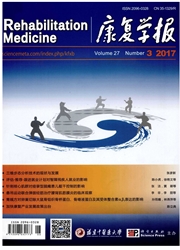

 中文摘要:
中文摘要:
目的:探讨使用吞咽造影(VFSS)数字化分析方法评估鼻咽癌放疗术后的吞咽功能与正常人吞咽功能的差异性。方法:选取中山大学附属第三医院康复科收治的鼻咽癌放疗后出现吞咽困难的13例患者和向社会招募10例无鼻咽癌放疗史及其他影响吞咽功能疾病的健康成年人,并将其分别分为实验组和对照组,以VFSS数字化分析评定2组受试者的吞咽困难障碍程度。结果:鼻咽癌患者的口腔运送时间、软腭上抬时间、食管上段括约肌(UES)开放时间、舌骨向前位移、UES开放幅度等时间学参数和运动学参数与健康成年人比较,均有不同程度的变化且差异具有统计学意义(P〈0.05)。结论:吞咽造影数字化分析能够有效地量化吞咽功能,是检测吞咽障碍的金标准。
 英文摘要:
英文摘要:
Objective:To evaluate the differences of swalling function in patients with nasopharyngeal carcinoma after radiotherapy and healthy people by using digital analysis of videofluoroscopic swallowing study(VFSS). Methods:Thirteen patients with nasopharyngeal carcinoma after radiotherapy were selected as the experimental group. And ten healthy people without thistory of nasopharyngeal carcinoma radiaton and other diseases which can affect swallowing function in society were recruited as the control group. All subjects were assessed by VFSS. Results:The experimental group showed significant differences in oral transit time,soft palate elevation time,hyoid vertical displacement,as well as the opening time and range of upper esophageal sphincter(UES) compared with the control group(P〈0.05). Conclusion:Using digital analysis of VFSS can quantify swallowing function, it is the golden standard test for detection of dysphagia.
 同期刊论文项目
同期刊论文项目
 同项目期刊论文
同项目期刊论文
 期刊信息
期刊信息
